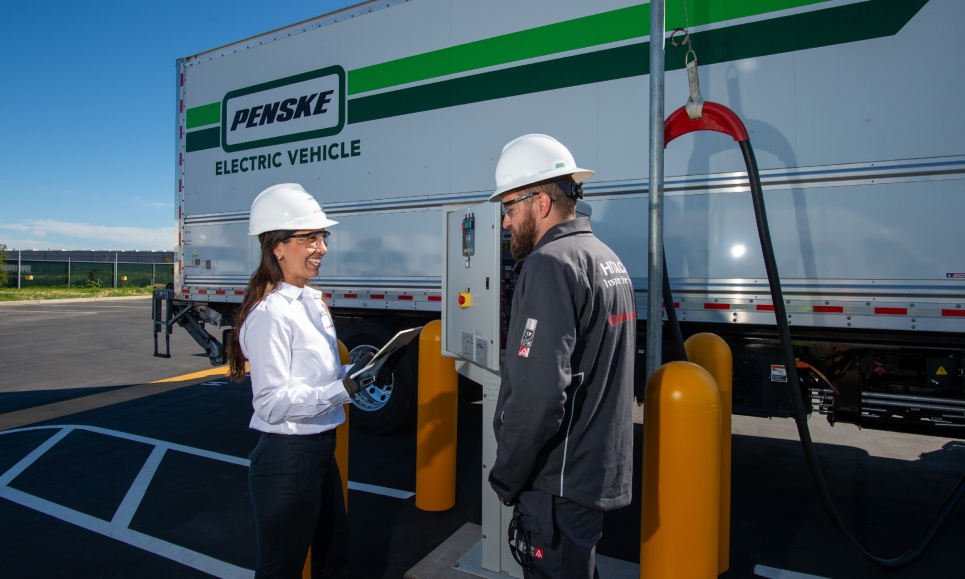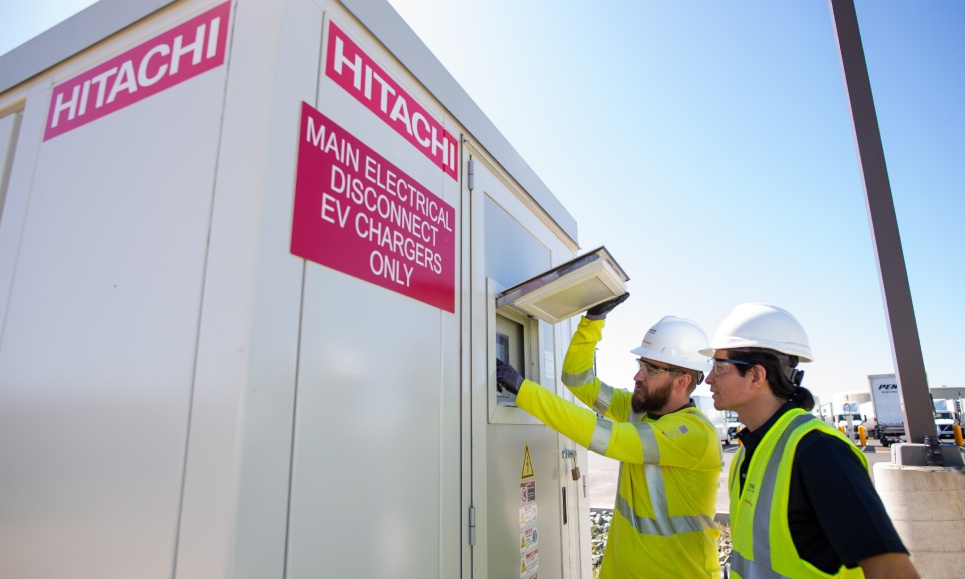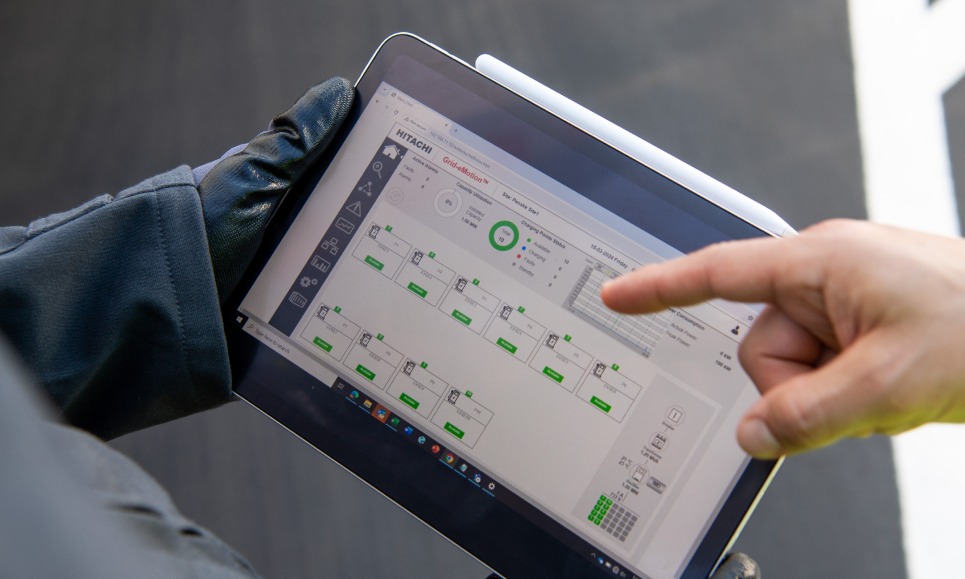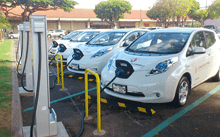As the state of California approved regulations to phase out the sales of medium and heavy-duty internal combustion trucks by 20361, Hitachi and Penske Truck Leasing were already in the midst of developing a ground-breaking commercial fleet truck charging depot in Stockton, California.
Penske Truck Leasing is a leading provider of innovative transportation solutions. It operates and maintains over 445,800 vehicles and serves customers from over 990 maintenance facilities and over 2,500 rental locations across North America.
The facility in Stockton is the first truck charging depot to use Hitachi Energy’s Grid-eMotion® Fleet charging system, a full grid-to-plug system for large-scale public transport and commercial fleets. Grid-eMotion® Fleet, which is tailored to meet the demanding requirements of truck fleets of varying sizes, can scale up and deliver multi-megawatt level charging capabilities.
“Being first in this Electric Vehicle (EV) journey takes partnership, a lot of hard work and joint focus,” says Bill Combs, vice president of sustainability for Penske. “And that's what we have here with Hitachi. We want to show the entire transportation industry what’s possible.”
Hitachi and Penske have a longstanding partnership, which has been cultivated through their mutual commitment to innovation, technology and sustainability. Hitachi has built Artificial Intelligence (AI)-infused technology that helps Penske technicians identify issues faster and predict what maintenance should be done on vehicles to prevent equipment failures.
“Both Hitachi and Penske have a pioneering spirit,” says Brijesh Khanna, senior vice president and innovation leader at Hitachi America, Ltd. “We share the same values to solve big problems for society and build a sustainable future.”
Three years ago, Hitachi approached Penske about co-creating the truck charging depot. Hitachi Energy had already put up 25 Grid-eMotion® Fleet installations around the world, primarily for charging municipal buses.
The time was ripe for such a venture on many levels. Penske operates thousands of fleets for its customers —each of whom faced their own pressures from their customers, employees, investors, and other stakeholders to build a sustainable future.” Combs says.
In April 2023, California’s Advanced Clean Fleet (ACF) rule was passed, mandating truck fleet operators in the state to transition their diesel vehicles to electrification or other zero-emission vehicles by 20361. Penske has been a pioneer in adopting battery electric commercial vehicles. The company has made big investments in testing, maintaining, and expanding charging infrastructure to support these vehicles. Taking part in advancing a leading-edge charging solution was right in their wheelhouse.

Hitachi Energy, which has a 130-year legacy of developing sophisticated power systems, contributed key technology that is used in demanding applications, such as rail. This included traction transformers, which are responsible for adjusting the voltage levels of energy from the power grid into the specific voltage and frequency needed to power electric trains. The company’s rectifier technology supports the conversion of power between alternating current (AC) and direct current (DC).
Grid-eMotion® Fleet users can connect directly to DC-based utility grids. This approach removes the complexities of integrating AC-DC conversion into a charging system. Compared to a conventional connection to the AC grid, Grid-eMotion® Fleet requires 60% less space for large-scale EV fleet charging, while reducing the depot cabling needed by 40%.
The system is designed to be flexible, versatile, and easy-to-install. The Stockton facility can accommodate the full range of vehicles in Penske’s sprawling fleet, from Class 2 panel trucks to Class 8 tractor trailers.

In a data-driven world, the Stockton charging depot also makes significant use of smart mobility and data analytics. Grid-eMotion® Fleet uses Hitachi Energy’s smart energy management solution, e-mesh (EM) to manage and enhance the complete charging infrastructure, as well as to calculate energy consumption.
Electric trucks don’t have the same predictable mileage as vehicles which use internal combustion engines. For commercial EVs, range can vary widely depending on the load, the environmental conditions and the driving behavior of the person behind the wheel.
“You need a software solution that removes the guesswork and can predict how much load is going to be in the vehicle and therefore how much charge needs to be done,” Khanna says. “Smart charging reduces your costs because electricity costs vary from time-to-time, so you don’t want to be paying more for electricity by charging at high-cost periods if you don’t need to. In addition, you do not have to charge the battery to the fullest extent every time, and therefore you extend the life of the battery.”

Like most leading-edge projects, the truck charging depot required several pivots. Just two years ago, the Stockton facility was a barren field, without a power line. The nearest transformer was a quarter of a mile away. Pacific Gas & Electric (PG&E), the Oakland-based utility, worked with Hitachi and Penske to provide the medium voltage that is transmitted to the Grid-eMotion® Fleet charging system.
“The biggest factors for success on a project like this are really to have a collaborative team, but also to be able to pivot when design changes or improvements on the final product need to be made,” said Sean Yentsch, vice president of facilities for Penske.
With the transportation sector producing up to about 28% of the U.S. total greenhouse gas emissions2, that type of collaborative innovation will be required to meet the world’s sustainability goals. “Going forward Penske has shared with us what their vision is for EV charging of the future,” says Daniel Mantey, vice president of marketing and sales for Hitachi Energy. “We directly took those requirements as input into our R&D requirements for the next generation of EV Fleet charging technology.”
Hitachi and Penske are raising the bar on innovation for a more sustainable transportation industry.







